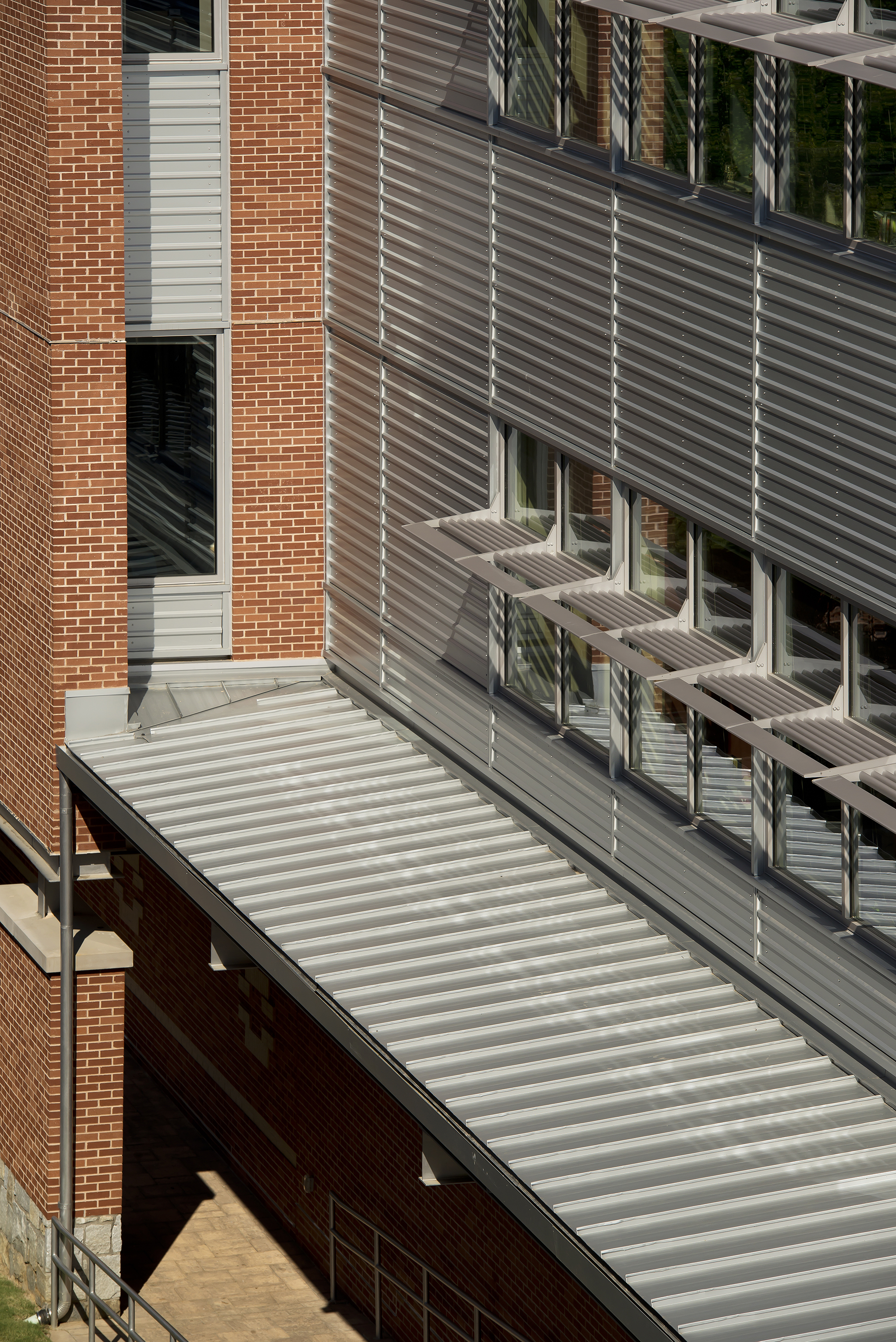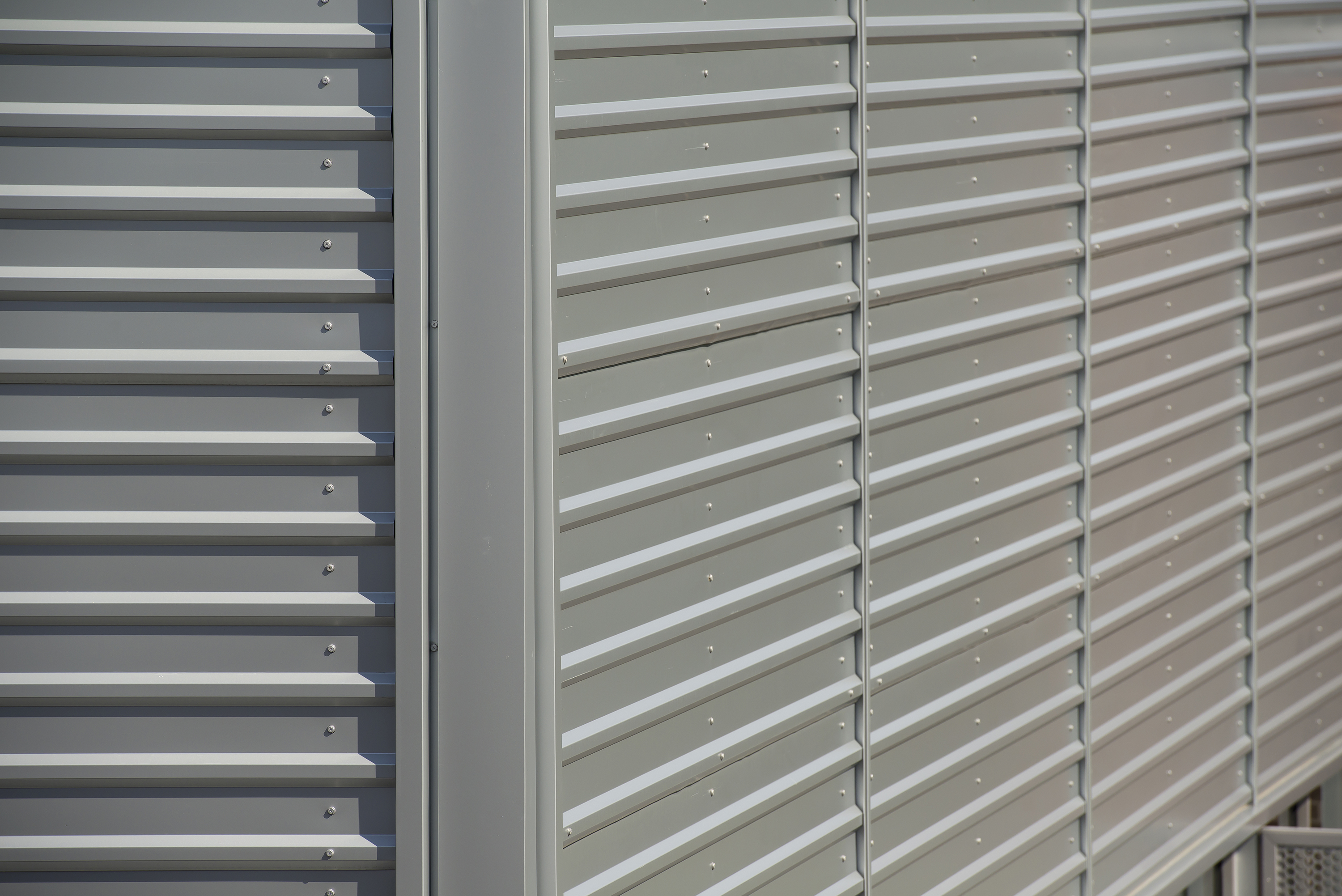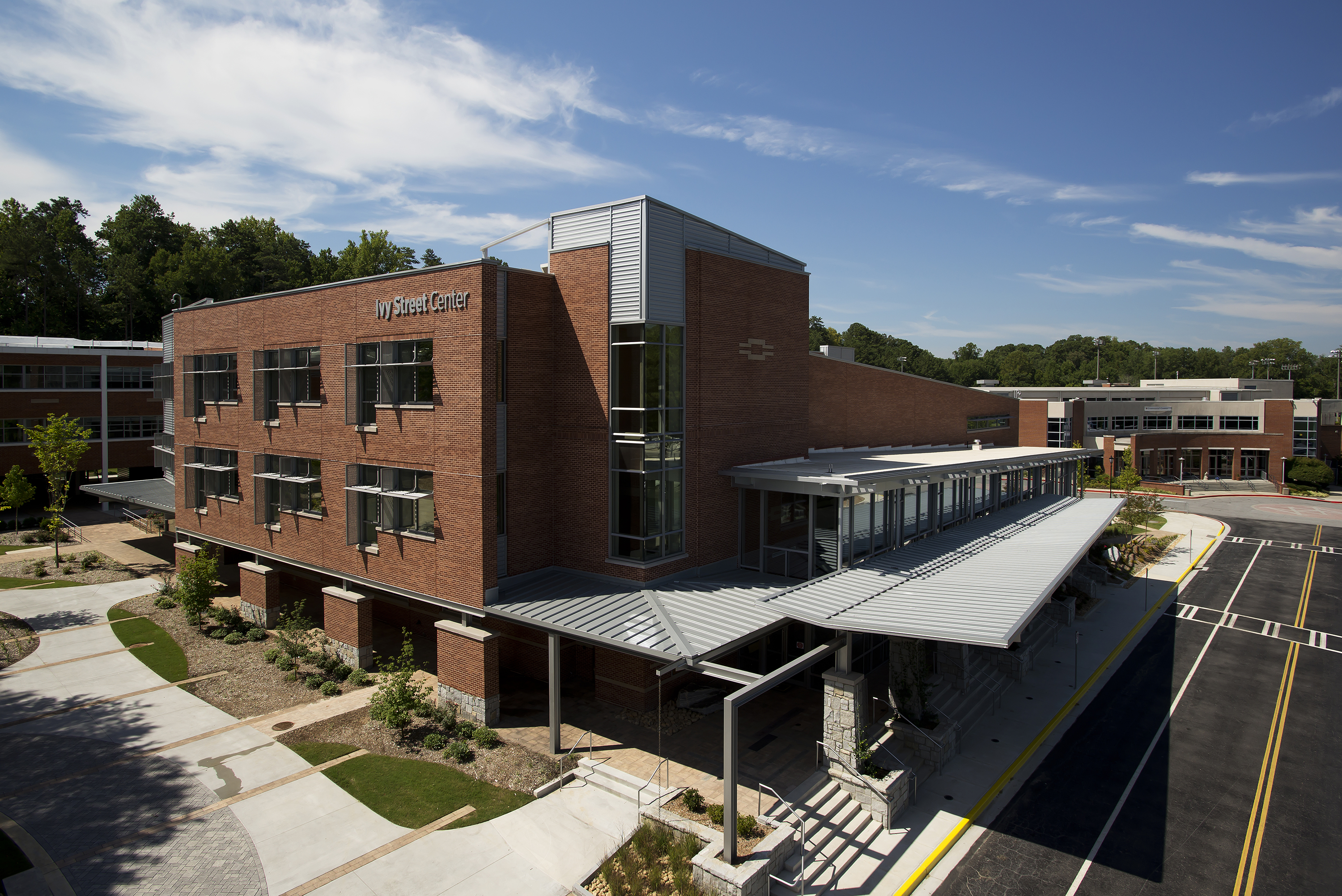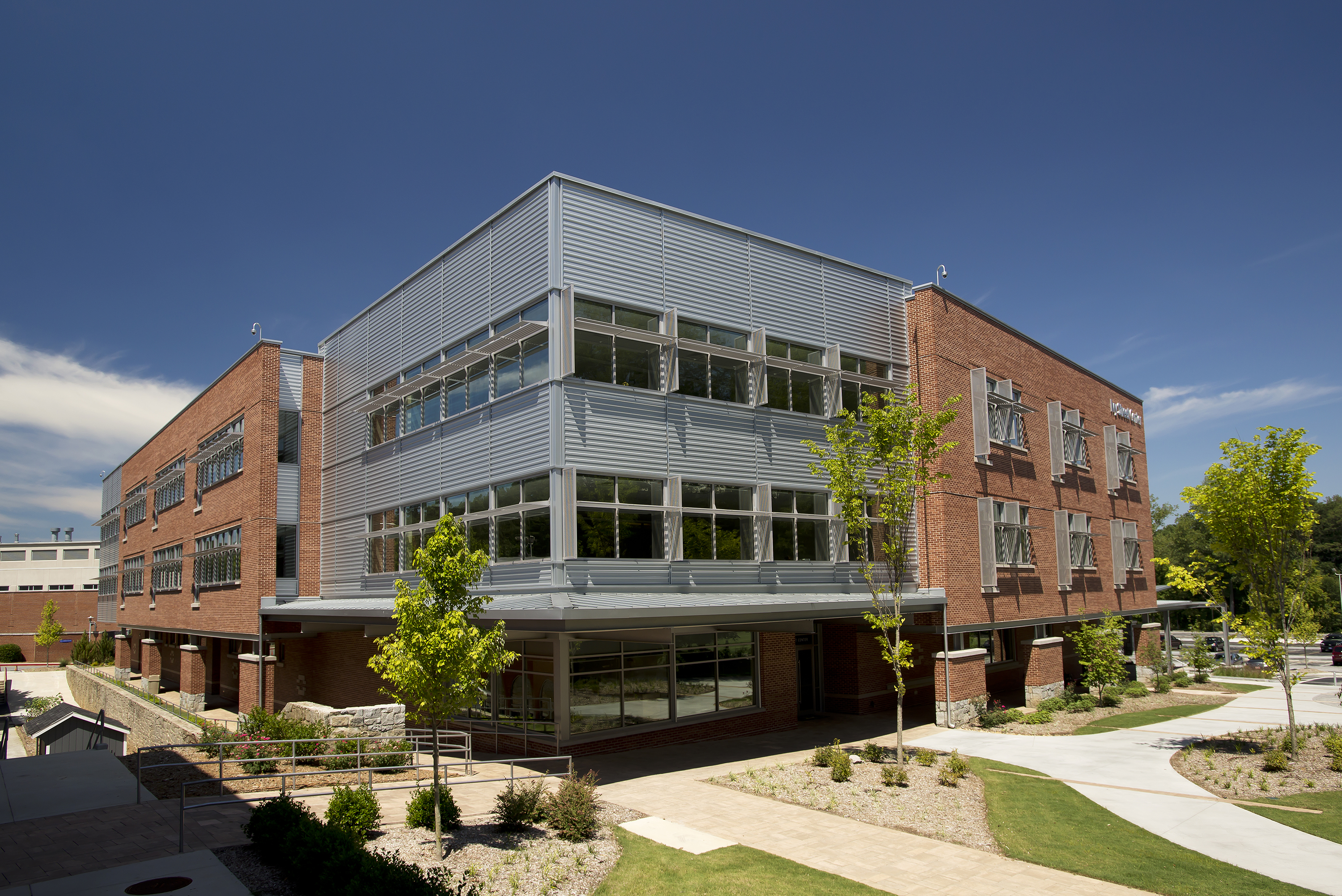Ivy Street Center is the first new academic building on the Marist School campus in Brookhaven, Ga., in more than 20 years, and is the signature project in Phase 1 of the Campus Master Plan. Marist School is a private Roman Catholic college preparatory school serving 1,100 students in grades 7-12. The new 55,000 sq. ft. Ivy Street Center serves as home for the mathematics and English departments. The building’s name pays homage to Marist’s original three-story schoolhouse located on Ivy Street (now Peachtree Center Avenue) in downtown Atlanta.
Architectural design was created by S/L/A/M Collaborative, Atlanta. Will Stelten, design architect and a 1985 graduate of Marist, said the school community chose carefully to design a building that will serve students for years. “Marist gets full credit for embracing this. They took this farther than any other client has,” Stelten said.
The structure was built on the footprint of the razed Kuhrt Gym, a 50-year-old building. “The charge was to design a combination classroom building that wrapped around a new gymnasium,” Stelten said. The new building now offers 16 classroom spaces, a tiered lecture hall, a 275 seat gymnasium plus collaborative areas and a campus store.
Two PAC-CLAD profiles were specified for roofing and wall applications on the three-story, highly-sustainable structure. Approximately 6,000 sq. ft. of Petersen Aluminum’s M-36 wall panels were used to clad a major portion of the façade. An additional 6,000 sq. ft. of Tite-Loc Plus roof panels were used on large canopies and overhangs at prominent locations on the building.
All panels were finished with Valspar Fluropon Silver and manufactured at Petersen Aluminum’s Acworth, Ga., plant. The Tite-Loc Plus panels were distributed by Commercial Roofing Specialties in College Park, Ga.
The building is larger than most on the campus, Stelten notes. “We felt that introducing the metal panels helped lighten the building and break up the massing in a way that made it more interesting,” he said. “The M-36 panel is an interesting profile to use on a building like this. It has deep shadow lines that help add lightness and a horizontal feel.”
The PAC-CLAD M-36 wall panels were installed by SECO Architectural Systems, Snellville, Ga. “Exposed fastener panels are often thought of as an industrial or utilitarian type of system,” said Joe Creighton, president of SECO. “But when they are installed horizontally, the panels suddenly create a nice architectural effect. The flashings become much more important and the folded corners add interest.”
 The original design called for aluminum composite material to be used for the siding, but that proved to be too expensive. SECO worked closely with the general contractor, Brasfield & Gorrie, to arrive at an affordable solution that met the architectural design criteria. “One of the options I gave the GC was the Petersen M-36 system. It was quite a departure from the original plan but it was aluminum, it was silver and I knew it would make a nice statement with the right detailing. After quite a bit of discussion, we got to the point where the architect liked the look and the owner could afford it,” Creighton said.
The original design called for aluminum composite material to be used for the siding, but that proved to be too expensive. SECO worked closely with the general contractor, Brasfield & Gorrie, to arrive at an affordable solution that met the architectural design criteria. “One of the options I gave the GC was the Petersen M-36 system. It was quite a departure from the original plan but it was aluminum, it was silver and I knew it would make a nice statement with the right detailing. After quite a bit of discussion, we got to the point where the architect liked the look and the owner could afford it,” Creighton said.
The key to the job was pre-planning and attention to detail, Creighton added. “There was a high degree of both and that’s what led to success. The M-36 panel really makes for a nice architectural look and not for a lot of money.”
The second PAC-CLAD system used on the job was Petersen Aluminum’s Tite-Loc Plus roofing panels. Installation of the Tite-Loc Plus panels was done by Saco Systems, Suwanee, Ga. John Salo, vice president, said the double-lock, mechanically seamed panels “are about as structurally sound as you can get. They are highly engineered panels that satisfy the most stringent design criteria.” Saco Systems has considerable experience in working with Petersen Aluminum profiles. “There were no real challenges on the project other than the normal coordination with other trades,” Salo said. “The panels went down easily and the job came out great—that’s the way we like it!”
Marist School made a commitment to environmental stewardship as it built the new facility. “Sustainability has been a big feature on the campus. It fits in with the overall philosophy of the school,” said Marist Father John Harhager, school president.
Sustainability features of the building include a three-part daylight harvesting system of exterior sunshades, interior light shelves and sloped ceilings. Glare inside classrooms is minimized, and daylight reaches deeply into rooms, allowing classroom lights to remain off the majority of the time. Rain water is saved to a 3,400-gal. cistern filled from two sources: the sloped gym roof and condensate from the HVAC system. The water in the cistern is used for irrigation of the planted rain garden. The building also features water bottle refill stations to reduce disposable water bottle waste. Sustainable materials include colorful sound-absorbing panels made of machine pressed, recycled plastic bottles in the gymnasium, reclaimed elm wood panels in the lobby, and locally sourced materials.

Long-recognized as an industry leader in metal standing seam roofing products, Petersen also offers exposed fastener panels, flush panels, composite wall panels and column covers. All provide the well-known Petersen quality and are available in PAC-CLAD® Kynar 500® finish in 38 standard colors on steel and 37 aluminum. Most colors meet LEED, ENERGY STAR and cool roof certification requirements.
For more information on the complete line of Petersen metal products, call 800-PAC-CLAD or visit www.pac-clad.com.
Related Stories
| Apr 16, 2012
University of Michigan study seeks to create efficient building design
The result, the researchers say, could be technologies capable of cutting the carbon footprint created by the huge power demands buildings place on the nation’s electrical grid.
| Apr 16, 2012
Batson-Cook breaks ground on senior living center in Brunswick, Ga.
Marks the third Benton House project constructed by Batson-Cook.
| Apr 16, 2012
$80 million in export financing for solar project in India
The project, “Rajasthan Sun Technique Energy Private Limited,” is a subsidiary of Reliance Power and is being co-financed by the Asian Development Bank and FMO, the Dutch development bank.
| Apr 13, 2012
Goettsch Partners designs new music building for Northwestern
The showcase facility is the recital hall, an intimate, two-level space with undulating walls of wood that provide optimal acoustics and lead to the stage, as well as a 50-foot-high wall of cable-supported, double-skin glass
| Apr 13, 2012
Best Commercial Modular Buildings Recognized
Judges scored building entries on a number of criteria including architectural excellence, technical innovation, cost effectiveness, energy efficiency, and calendar days to complete, while marketing pieces were judged on strategy, implementation, and quantifiable results. Read More
| Apr 12, 2012
Solar PV carport, electrical charging stations unveiled in California
Project contractor Oltman Construction noted that the carport provides shaded area for 940 car stalls and generates 2 MW DC of electric power.
| Apr 11, 2012
Corgan & SOM awarded contract to design SSA National Support Center
The new SSA campus is expected to meet all Federal energy and water conservation goals while achieving LEED Gold Certification from the United States Green Building Council.
| Apr 11, 2012
C.W. Driver completes Rec Center on CSUN campus
The state-of-the-art fitness center supports university’s goal to encourage student recruitment and retention.
| Apr 6, 2012
Rooftop solar energy program wins critical approval from L.A. city council
Los Angeles Business Council applauds decision allowing LADWP to create new national model for rooftop solar energy
| Apr 5, 2012
5 tips for a successful door and window retrofit
An exclusive tip sheet to help the Building Team manage door and window retrofits successfully.















